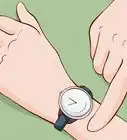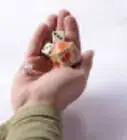wikiHow is a “wiki,” similar to Wikipedia, which means that many of our articles are co-written by multiple authors. To create this article, 21 people, some anonymous, worked to edit and improve it over time.
wikiHow marks an article as reader-approved once it receives enough positive feedback. This article received 25 testimonials and 90% of readers who voted found it helpful, earning it our reader-approved status.
This article has been viewed 1,193,552 times.
Learn more...
'Bunco, also known as Bonko or Bunko, is a popular game played with nine dice and a whole lot of luck. Play bunco at parties, with family, or with your 11 other friends that you got stranded on an island with. Follow these steps to learn how to play.
Steps
Setting Up Bunco
-
1Know the object of Bunco. Players roll dice and accumulate ‘wins’ (or "buncos".) The person with the most wins or Buncos at the end of the game is the winner.[1]
-
2Know how to form a bunco. Each round correlates to a number on the die; the first round correlates with the one on the die, round two correlates with the two, etc. If a player rolls the dice and gets three of the number that the round correlates to, the person gets a bunco.
- Example: If it is round four and the player rolls the dice and three of them land on four, that player gets a bunco.
Advertisement -
3Find a group of 12 people to play with. Bunco is played with 12 people because it is divisible by four.[2]
- If you are playing with more or less than 12 people, make sure that you are playing with enough people so that there are four players at each table.
- If you are playing with an odd amount of people, assign a “ghost” to someone. The partner of the “ghost” rolls and keeps score for the “ghost”. Essentially one person on the team with an uneven number gets to roll and keep score twice.
-
4Understand what the head table is. The head table controls the pace of the game. The game begins with the head table rings the bell. To pick the players who will be at the head table:
- Collect all 12 score sheets. Assign someone to draw small stars on four of the card sheets.
- Shuffle the sheets. Have each player select a sheet. Those who pick sheets with stars are the players who will begin at the head table.
-
5Divide the rest of the players between two tables. There should be four people at each table. A typical Bunco game consists of three tables--one “losing” table, one “middle” table and one head table. The head table is the best, the middle is middle, and the losing table is worst.
-
6Divide each table into teams. People across from each other are teammates. However, keep in mind that this will change every round.
-
7Pick a scorekeeper for each team. This person will play the game, but will also be in charge of keeping track of points for the team he/she is on.
-
8Give each table what they'll need to play. Each table should have a spiral notebook to write the score in, 3 dice, a score sheet for each player, and a pencil for each of the four people at the table.[3]
Playing Bunco
-
1Begin round one of the game. One person at the table will take the three dice and roll them. They will want to get as many 1s as possible, as this is Round 1.
- For each 1 that he/she roll, they get one point unless they roll three 1s, which would be a 21 (the highest amount of points possible). This is called a "bunco", hence the name of the game. When a player gets a bunco, they should yell "Bunco!" Mark a hash mark on the player’s card that got the bunco.
- If the player rolls three of a kind, but they're not 1s, he/she gets five points, but not a bunco.
-
2Let the first player continue to roll until he/she doesn’t roll the number needed. When he/she doesn’t get the number, the dice is passed to the left. For example, in the first round, if a player rolls the dice and gets a 3, 4, and 6, he/she must pass the dice to the next player because none of those dice were 1s.[4]
- The dice must also be passed as soon as a player scores 21 points. This could either be achieved by getting a bunco or rolling the dice so that at least one of the die is the number needed and adding that to the existing score.
-
3Finish round one. When a team from the head table gets 21 points or more, the round is over. That team must yell out “game!” The scorekeeper at the head table rings the bell to signify the end of the round. The team at each table with the most points is the winner of that round for each individual table.
- Players can finish up the roll that they started when the bell was rung.
- If there is a tie between teams at a table, one person from each team must roll one die. The person who rolls the highest number wins for his/her team.
-
4Winning teams write a W on their cards. Losing teams (those with fewer points) write an L on their cards. Shift teams accordingly.
- The winning team at the head table stays at the head table. The losing team at the head table goes down to the middle table.
- The winning team at the middle table moves up to the head table. The losing team moves down to the losing table.
- The winning team at the losing table moves up to the middle table. The losing team stays at the losing table.
-
5Switch partners. You do not have to do this, but it makes the game more lively. Once each team has moved to the appropriate table, switch partners so that you make up a whole new team.
-
6Continue playing. Move to round two (the new number that the teams must hope to roll is 2.) There are six rounds in Bunco. Playing all the way to round 6 completes one hand of the game.
-
7Keep score. You should keep score by a team (you and the person you're facing) and individually (how many buncos you've gotten).
-
8Determine the winner. After all of the rounds are over, each player should count up the number of buncos they have, as well as how many wins and losses. You can either play that the person with the most buncos wins, or the person with the most buncos and ‘wins’ wins. Award prizes accordingly.[5]
Community Q&A
-
QuestionWhat do you award prizes for in Bunco?
 Community AnswerAnything! The host could buy prizes and each person could bring $5 to reimburse them. You could have prizes for the most Wins, the second most Wins, the most Buncos and even the most losses!
Community AnswerAnything! The host could buy prizes and each person could bring $5 to reimburse them. You could have prizes for the most Wins, the second most Wins, the most Buncos and even the most losses! -
QuestionWho gets the points if the ghost rolls a bunco?
 Community AnswerGhosts: A ghost is used if an individual cannot attend and could not find a sub. The player with the ghost for a partner rolls for the ghost and collects only points for their team, not buncos or baby buncos, etc. Ghost players will not have a scorecard.
Community AnswerGhosts: A ghost is used if an individual cannot attend and could not find a sub. The player with the ghost for a partner rolls for the ghost and collects only points for their team, not buncos or baby buncos, etc. Ghost players will not have a scorecard. -
QuestionWhat does travel mean?
 Community AnswerTravel occurs when you pick a combination of numbers that, when rolled by any player, gets them the "special" object (fuzzy dice, bean bag, etc). If a player rolls the picked combo of numbers, they yell "travel" and the object gets passed from the last holder. The player holding the object at the end of the game gets awarded a portion of the prize money.
Community AnswerTravel occurs when you pick a combination of numbers that, when rolled by any player, gets them the "special" object (fuzzy dice, bean bag, etc). If a player rolls the picked combo of numbers, they yell "travel" and the object gets passed from the last holder. The player holding the object at the end of the game gets awarded a portion of the prize money.
Things You'll Need
- 3 card tables
- 12 chairs
- 3 spiral notebooks (one per table)
- 12 pencils (one per person)
- 9 dice (3 per table)
- 12 score cards (one per person)
- Bell
- Prizes
- Snacks and Beverages
References
About This Article
Bunco is a fun dice game where players try to roll and score the most points over a series of rounds. Bunco is usually played with 12 players and 3 tables, with 4 players sitting at each table. You can play with more or less players as long as the total number of players is divisible by 4. You’ll need 3 dice for each table, 1 Bunco table tally sheet for each table, 1 Bunco score sheet and a pencil for each player, and a bell for one of the tables. Number the tables 1, 2, and 3, and place the bell on the first table (also called the “head table”). Have 4 players sit at each table—players who are across from each other will be partners for round 1. Choose one scorekeeper at each table who will be responsible for writing down each team’s points on the table tally sheet. To start the game, a player at the head table rings the bell. Then, all of the scorekeepers begin rolling the three dice at their table. After each roll, points for the dice rolled are calculated and added to the table tally sheet. For each dice that matches the number of the round being played, 1 point is scored. For example, any 1’s rolled during round 1 are worth 1 point, any 2’s rolled during round 2 are worth 1 point, and so on. Dice cannot be added together. If a player rolls three of a kind in a number that matches the number of the round, like three 4’s during round 4, that’s a Bunco. They would call out “Bunco” and score 21 points. If they roll three of a kind in a number that doesn’t match the round number, like three 5’s in round 2, that’s a mini Bunco. A mini Bunco is worth 5 points. The scorekeeper continues rolling until they roll no points. Then, the dice are passed to the player on their left. This player now takes their turn rolling. Players continue rolling the dice and passing them around their table until one team at the head table scores 21 or more points and rings the bell. Once the bell has been rung, any player who is still taking their turn can finish it. Then, the round is over. After each round, the players on the winning team each write a “W” on the line for that round on their individual Bunco score sheet. The rest of the players write an “L” on the line for that round. To start the next round, all of the players change seats. The winning players stay at the head table, but one of them changes seats so they have a new partner the following round. The two losing players at the head table swap seats with the two winning players at table 2. The two losing players at table 2 swap seats with the two winning players at table 3. The losing team at table 3 stays at the same table, but one of them changes seats so they have a new partner. Once all of the players are in their new seats, a new scorekeeper is chosen at each table, and another round begins. The game continues for 6 rounds. After 6 rounds, all of the players tally their individual wins and losses across all of the rounds and write their final score on their Bunco score sheet. Whoever has the most wins is the winner! Keep reading to learn how the players should rearrange themselves after each round!
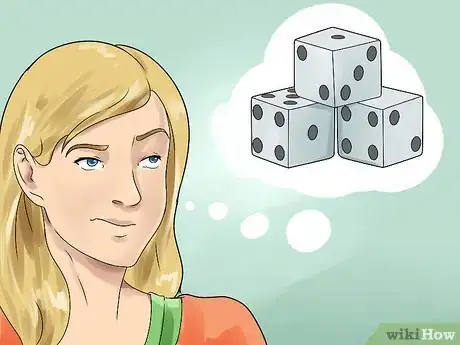


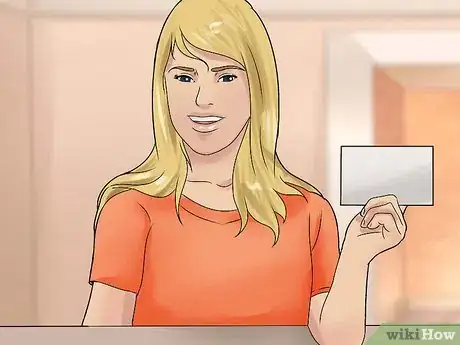


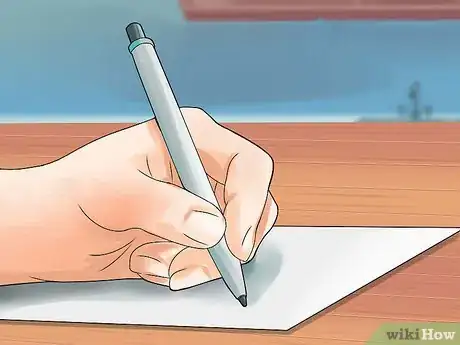

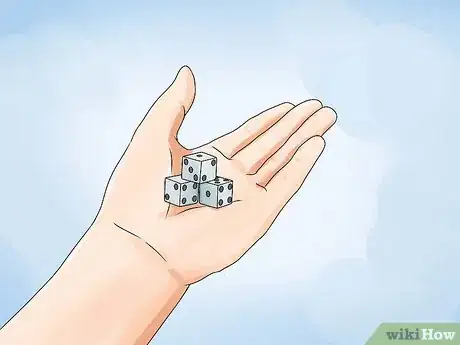



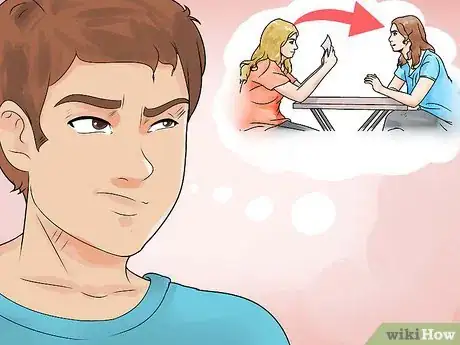
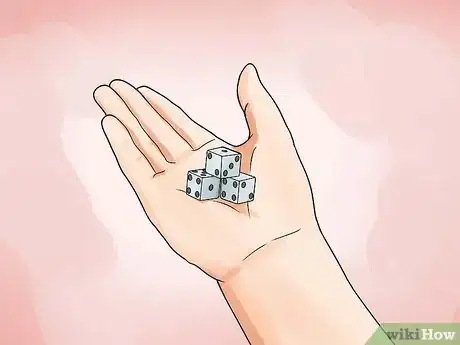

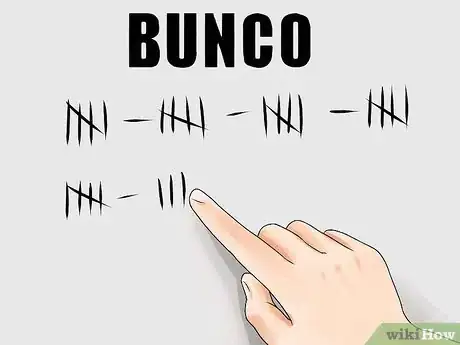


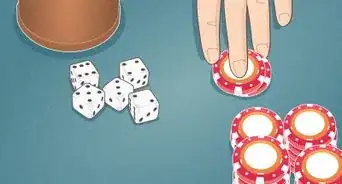

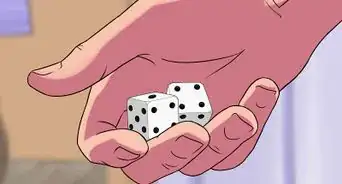

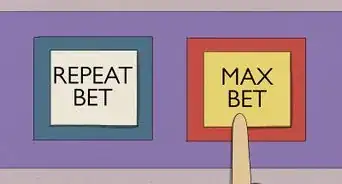
-Step-35.webp)
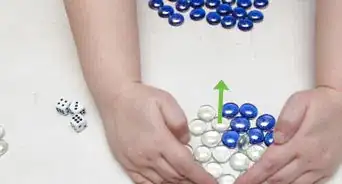
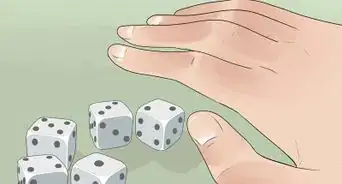
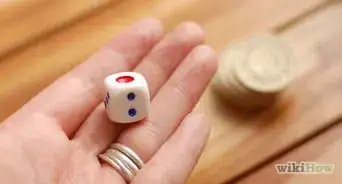
-Step-10.webp)












